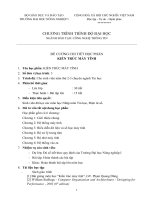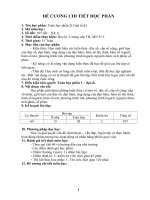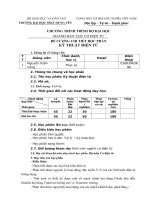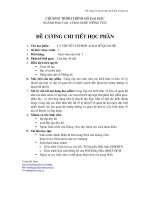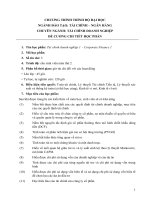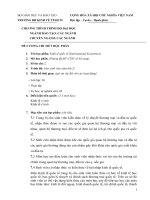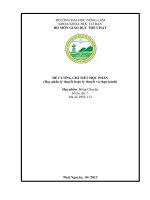Đề cương chi tiết học phần Mô tả CORPORATE FINANCE 1 (Học viện tài chính)
Bạn đang xem bản rút gọn của tài liệu. Xem và tải ngay bản đầy đủ của tài liệu tại đây (141.27 KB, 4 trang )
CORPORATE FINANCE
ACADEMY OF FINANCE
SUBJECT SYLLABUS
Subject: Corporate Finance 1
Lecturer:
Name:
Email:
Mobile:
Subject general information
• Number of credits: 3 ( 60 periods include 40 periods in class and 20 periods self-study)
• Subject: Required
• Subject Audience: Students of English major
Subject description
This subject aims to introduce students to finance and helps them acquire the basic
analytical skills required to make informed financial decisions. Topics include the goal of
financial management, introduction to the time value of money, risk and return, the
financial statements analysis. Working capital management and financial planning are also
introduced.
Subject learning objectives
On successful completion of this subject students should be able to:
• Know English vocabulary in the field of corporate finance
• Know how to read reference materials and work effectively in international
environment
• Understand the role of financial management
• Explain the goal of financial decision and the importance of financial information.
• Access to the basic principles of finance and the key tools to make financial decisions
that are time value of money, risk and return and ratio analysis.
• Understand the working capital management and the financial planning
Learning resources
Required texts:
• Textbook: Dr.Vu Van Ninh, Corporate finance.
• Lecture Notes
Recommended texts
• Ross, Thompson, Christensen, Westerfied, Jodan, Fundamentals of Corporate
Finance, Fith Australian Edition, McGraw 2011
• Glend Arnold, Corporate Financial Management, Fouth Edition, Prentice Hall 2010
• Ross, Westerfied, Jaffe,Corporate Finance, Seventh Edition,McGraw 2010
• Jaffe, Essentials of managerial Finance – Twelfth edition, Scott Besley and Eugene
F.Brigham
• Brealey and Meyers, Principles of Corporate Finance, Seventh Edition -2006.
• Aswsth Damodaran – Corporate Finance- Theory and Practice, John Wiley & Son,
Inc Copyright 1997
….
Assessment process
There are five parts to the assessment for this subject. These are:
Class Participation
5%
Assignments
5%
Case Study
10%
Midterm exam
10%
Final exam
70%
Total
100%
Class Participation
Attendance of lectures is required. Assessment of class participation will based on your
contribution to the class discussion and analyses, not simply on your attendance.
Assignments
You must do exercises and answer questions in your textbook. Besides, you have to
complete the task assigned by lecturer. The assignments give you opportunities to
demonstrate your preparation for that day’s class discussion, and to demonstrate your
understanding from readings and prior classes
Team Case Study
The case study is conducted as a group assignment. It will provide you with the
opportunity to apply your knowledge to a real life situation as well as helping you to
develop writing and spreadsheet skills. You will combine yourselves into groups of up to
ten students. No more than ten students will be allowed in any group. Students may
complete the case study individually. All students must complete the case study.
Remember that it is your responsibility to ensure the assessment deadlines are met. There
will be a penalty for all late submissions.
2 MARKS DEDUCTED FOR EACH DAY LATE.
Midterm exam
This will be an in-class, closed book exam. Students will be advised of the nature of the
exam in advance of the examination period.
Final Exam
If you participate at least 11/14 sessions in full, complete a midterm exam and a case
study you will have a right to attend final exam.
The exam will cover the entire course and will be two hours long.
Content
Chapter 1: Overview of corporate finance
Chapter 2: The time value of money
Chapter 3: Risk and return
Chapter 4: The financial statements analysis
Chapter 7: Working capital management and financial planning
Program
Number
Procedure( In class)
Content
Theory
1.
1.1
1.2
1.3
1.4
1.5
1.6
2
2.1
2.2
2.3
2.4
2.5
2.6
Chapter 1: Overview of
corporate finance
Forms
of
business
organization
Corporate finance and
corporate
financial
decisions
The financial manager
The goal of financial
management
Financial markets and the
corporation (*)
Summary
Chapter 2: The time
value of money
Future
Values
and
Compound Interest
Present value
Future and Present Value
of Multiple Cash Flows
Level
Cash
Flows:
Perpetuities and Annuities
Inflation and the time
value of Money (*)
Summary (*)
Exercise Discussion Practice Exam
3
1
1
0.5
1
0.5
Total
period
Self-
4
10
6
12
0,5
0.5
4
2
1
0.5
1
0.5
1
0.5
1
0.5
3
3.1
3.2
3.3.
3.4
4
4.1
4.2
4.3
4.4
7
7.1
7.2
7.3
Chapter 3: Risk and
return
Risk and returns
Measuring risk
Relationship between risk
and expected return
Summary (*)
Chapter 4: The financial
statements analysis
Financial statements and
reports
Ratio Analysis
Awareness using financial
statements (*)
Summary (*)
Chapter 7: Working
capital management and
financial planning
Working
capital
management
Financial planning
Summary (*)
Total
Note: (*) Self-study
6
3
1
3
2
2
1
6
3
1
4
3
1
5
3
1
4
2
0.5
1
1
0.5
24
11
3
9
20
11
20
1
10
12
1
40
74
1
2
1
TRƯỞNG BỘ MÔN
PGS.TS.Vũ Văn Ninh


